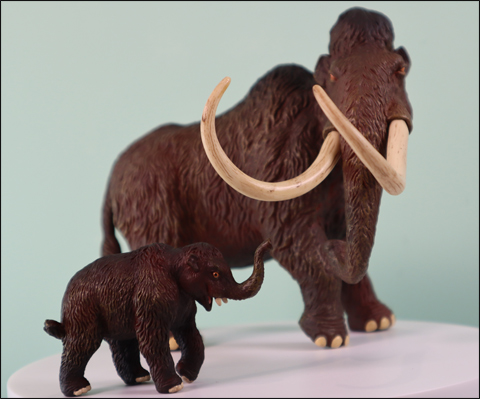Baby Mammoth Stomach Contents under Scrutiny
Baby Mammoth Reveals Secrets in Television Documentary
An almost perfectly preserved fossilised baby woolly mammoth is slowly and surely providing scientists with an insight into prehistory. The 4 foot high, grey and brown mammoth carcass was discovered by a reindeer herder a couple of years ago in the relatively remote Yanmal-Nenets region of Siberia. The calf, a female, is one of the best preserved mammoth specimens recovered to date and the almost perfect state of preservation has enabled scientists to gain fresh information on this ancient elephant species. The mammoth has been nicknamed Lyuba (after the reindeer herder’s wife); was studied by a team of scientists from the Russian Academy of Sciences before travelling to Japan for further analysis.
To view the article on the baby mammoth’s discovery: Baby Mammoth Found.
Stomach contents have been studied and the researchers have found faecal residues and traces of prehistoric milk in the digestive track. Analysis of the stomach contents of adult mammoths has provided evidence of what these huge herbivores ate, but to be able to study such a young animal is a very rare event.
Baby Woolly Mammoth
The baby was approximately one month old when she died, approximately 40,000 years ago (Pleistocene Epoch). The international team of scientists charged with researching the animal have suggested that this animal was healthy when she died, perhaps drowning or becoming trapped and suffocating in mud near the edge of a lake.
Using high tech equipment such as computer tomography and other forms of electronic scanning the research team have studied her bones, soft tissues and teeth. The stomach contents and digestive tract contained traces of her mother’s milk and the fat hump on the back of the head indicates that the calf was well looked after.
Commenting on the presence of a reserve of fatty tissue, one of the researchers, Daniel Fisher of the University of Michigan stated that the hump generated heat and was used by baby mammoths to stay warm during the first months of their lives. It has been presumed that mammoths would give birth in the spring to allow their youngsters to grow up in the warmer spring and summer months, but even if this assumption is correct, baby mammoths would have faced a harsh environment.
Fisher stated:
“This is the first time we have a really healthy specimen to study”.
“In the Pink”
Referring to Lyuba as being a mammoth very much “in the pink”, the scientists are excited about how much information the carcass will provide. Other baby mammoths that had been found including the famous preserved baby mammoth called Dima were not in very good shape when they died. For example, Dima was about nine months old when he died. Analysis of the carcass indicated that this mammoth was under nourished and very small for his age. The stomach had a high level of parasites preserved within it and their presence indicates that this particular animal was poorly.
A Model of a Baby Mammoth with an Adult Animal

The CollectA Deluxe Woolly Mammoth model in 1:20 scale and the CollectA Prehistoric Life Woolly Mammoth calf. Picture credit: Everything Dinosaur.
Picture credit: Everything Dinosaur
To view the CollectA range of scale prehistoric animal models including an adult Woolly Mammoth replica: CollectA Deluxe Prehistoric Animal Models.
The faecal material found in the female calf’s intestines was similar to an adult mammoth’s. It was likely that the mother encouraged her baby to eat dung to help establish a healthy microbial presence in the gut. This is typical behaviour seen in a number of extant mammals.
Daniel Fisher went on to state:
“We are learning more about what [mammoths] ate and how to recognise animals that are healthy versus stressed”.
Further study of Lyuba’s teeth may provide information on the environment at the time of her death providing clues as to what caused many Ice Age mammals to vanish at the end of the Pleistocene Epoch.
Scientists remain unsure as to what caused the extinction of a number of a large mammal species approximately 10,000 years ago (the demise of megafauna). The extinction of the mammoths is believed to have occurred relatively rapidly, some scientists believe human hunters may have played a significant role in the extinction of mammoths, others believe that climate change may have been the cause.
To view a model of a baby mammoth and other replicas of Pleistocene mammals including Ice Age animals: Prehistoric Animal and Dinosaur Models.

